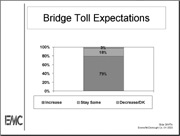The results are in and they look good for ferry service. The WTA commmisiioned a comprehensive survey of Bay Area votes to learn what and how much they want in the way of expanded public transit and ferry service specifically.

Published: March, 2002
You recently completed a comprehensive poll of Bay Area voters about ferries? How does it look?
We completed a 1,400-person interview survey among likely v
oters in seven Bay Area counties that voted on regional measure 1 back in 1988, in Alameda, Contra Costa, Marin, San Francisco, San Mateo, Santa Clara and Solano counties. What we found was a lot of voter frustration about traffic and concern with transportation that added up to a willingness to support plans to solve those problems. They were very supportive of ferries and increased spending on transportation and transit.
What do people think when they hear the arguments against ferry service?
It’s not that there aren’t arguments against ferry service that can’t be persuasive. It’s really that voters are so concerned about the amount of traffic and congestion in the Bay Area that they are more moved by the arguments in favor of ferry service.
How do ferries fit in with voters’ preferences when compared with other kinds of public transit options?
BART used to be the most popular form of public transportation in the Bay Area. Many times if you included BART in your ballot measure, you were likely to get more support for that measure. But ferries are very competitive in that environment with BART. But one of the most important findings in the survey was that voters are looking for multi-modal and inter-modal transportation systems so that they don’t want a measure that’s only for ferries or only for BART or only for buses. They want to be able to go from one system to another.
Are voters going to go along with increased bridge tolls to pay for better public transportation?
I believe that the voters are ready for an increase in bridge tolls. When we asked if they thought bridge tolls were going to go up or not, 79% said they expected bridge tolls to increase. So the expectation is there. I think what they are looking for is not whether an increase but rather how it should be spent. So voters are going to be supportive of it but there is one little catch here. You need two-thirds for the measure to pass. So when I say voters will support it, I mean a majority. It’ll be tougher getting the two-thirds vote but this survey shows that even in this environment where there is concern about terrorism and safety and in an economy that’s shown some weakness, they still support it.
What’s the margin of error in a poll like this? This poll was paid for by WTA. How can we know you’re not just telling WTA what it wants to hear?
The margin of error is under minus 2.7%, a number we get using a statistical formula based on the number of interviews. We know that these answers a
re within 2.7% of what we would find if we had interviewed every single voter.
What the WTA asked us to tell them was the truth so in that sense, we are telling them what they want to hear. They have a job to do which is to come up with a plan for the legislature on how to finance improvements in regional transportation in the Bay Area. Our job was to look specifically at what types of things might be in that plan and whether or not the voters would support that plan funded by a $1 increase. We’re not telling them what they want to hear about ferries because ferries alone won’t be the answer. It’s got to be multi-modal.
What do voters prefer when it comes to ferries – more service on existing lines or more routes?
They’re looking for new routes, not just more service.
How important are environmental issues to voters?
Very important particularly in this region. It seems that voters are taking a very broad view of environmental issues in that any effort to get people out of their passenger vehicles and onto transit is most important.
Would voters approve increasing gas taxes to pay for and encourage the use of public transit as well as increasing bridge tolls?
I think that the bridge tolls are the preferred method.


